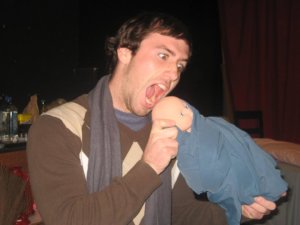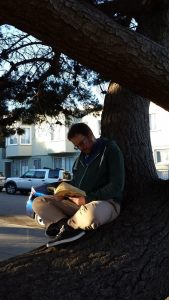Here’s part three of our INTO THE WOODS discussion panel (you should check out part one and part two if you haven’t) with Stuart Bousel, Brian Katz, Corinne Proctor, Marissa Skudlarek, Oren Stevens, and Nick Trengove. Today we’re winding the discussion down and looking at how this show has impacted us, as artists and as people. But first…
Is there a fairy tale you wish was included in Into the Woods but is not?
Corinne: Not really, no.
Brian: I find the nods to Grimm and Disney fun, but not my favorite parts of the show. Generally, I want more of the (somewhat) original tale of the Baker and his Wife.
Marissa: I can easily imagine a version of Into the Woods that incorporates “Hansel and Gretel.” It’s a well-known Brothers Grimm tale that involves journeying into the woods, parents & children, loss of innocence, baked goods, feeling “excited and scared” — so it would fit the style and themes of the show very well. But perhaps Sondheim felt like he’d already written enough about cannibalism in Sweeney Todd?
Nick: “Hansel and Gretel”, for sure. There could be a whole duet about, like, gingerbread or something. But seriously, where are their parents? They have that in common with Jack and Little Red – absent parental figures.
Stuart: Actually, in the Public Theatre production in 2012, they did work in “Hansel and Gretel” into the show, somehow. I’m not sure how. I’d like to know how, but for all my Googling I’ve only been able to come up with references to it in reviews and such, not an actual explanation of what happened or if material was added. “The Three Little Pigs” were also worked into the first Broadway revival, but as time goes on that whole production seems to be a case of “The Less Said the Better” so they are hardly “canon”.
Oren: Honestly, there are so many more fairy tales that could be woven in. But most of the ones I love are just a little too dark even for this show (“Donkeyskin” comes to mind — Wikipedia that shit), but actually what I’m most sad about is that “Sleeping Beauty” and “Snow White”, two incredibly well-known stories that have so much going on in them (mostly about gender politics — “Snow White” is a condemnation of female vanity and “Sleeping Beauty”, in its original form, involves an already married king cheating on his wife by impregnating the still sleeping princess), are given such short shrift. Ultimately, though, the show is so completely and tightly crafted that throwing any additional stories in there would throw the whole thing off balance — and throw the whole thing over the three hour mark.
Why are fairy tales something we keep coming back to- not just as the backbone for this show, but for so many shows? Why are they so endlessly appealing to many audiences?
Marissa: The rise of fairy-tale-themed entertainment in the last few decades is pretty astounding. Some of it can be attributed to capitalism and Hollywood (Disney got us Millennials hooked on fairy tales young, and now we’re loyal customers for life) but I also wonder if it could have a deeper, more spiritual meaning. Like, as the world becomes ever more technological and scientific, we’re trying to counter-balance that with these age-old tales of magic and mystery. I’d like to believe that. I think it’s important to cultivate the imagination. When I was a lonely teenager it always seemed to me like Rapunzel’s tower was a metaphor for the loneliness and isolation of adolescence, and having overprotective parents who don’t understand you. That’s a hard truth to face and sometimes it helps to face it in metaphorical ways, through the medium of a fairy tale. “Cinderella”, on the other hand, is an insidious tale because it teaches children that women who have big feet are grotesque. As someone who wears a size 10.5 shoe, I simply must protest.
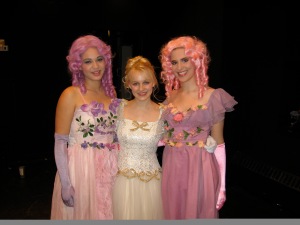
Once a stepsister, always a stepsister. Backstage at the 2006 Vassar College Drama Department production of Into the Woods. Summer Scott as Florinda, Noelle McMurtry as Cinderella, and our very own Marissa Skudlarek as Lucinda.
Stuart: All Cinderella bitterness aside, I am inclined to agree with Marissa: I think we need magic in our lives, not just right now, but always. I think the acute desire for magic becomes more pronounced in some eras over another, but it’s always there. And I don’t see it as escapism, but rather I think it’s tied in with the part of us that needs language, math, meaning. Myth and folklore are sense-making mechanisms, which we use to understand things like love, death, wonder, loyalty, betrayal, courage, fear- all those aspects of the human experience which we can’t truly explain but so desperately want explanations for. Fairy tales and myths are the language of the imagination, the attempt at charting the unchart-able, with a language as flexible as the thing it’s trying to capture.
Corinne: Fairy tales have staying power because of their simplicity. The stories aren’t tied to a particular time and place and the characters are archetypes that are eternally relevant. Fairy tales are satisfying because they paint a picture of a satisfying world that wish existed – a world where it is easy to tell the difference between right and wrong, where evil is punished and good people are rewarded. (Even the older, gorier, earliest fairy tales of oral tradition nearly always have a sense of justice and triumph of good over evil, though the picture of the world is much less rosy.) The brilliance of this show is how cleverly it contrasts the simple world of fairy tales and then deconstructs it as the characters face challenges that place them in a world more like our own – a world of grey areas and in-betweens where the right way isn’t clear and life is far from fair.
Nick: The strength of this musical comes from our cultural familiarity with fairy tales. We look to them, I feel, in some small way like the ancient Greeks looked to their myths. As sort of moral compasses, or cautionary tales. The lyrics are brilliant and the book’s fantastic, and they succeed in taking these deceptively simple parables and breathing fresh life into them.
Brian: Parents love fairy tales, because first of all they were taught them, so they are sharing a piece of themselves and, secondly, they are tales in which to learn life lessons like “don’t steal” and “don’t run away”. However, Woods and my own feelings go toward Dr. Bertleheim, which hopes that these tales are used in the way Woods uses them, not Disney: harder lessons are beneath their surfaces, such as coping with loss, and dealing with our hidden fears. But it’s because they can be explored on so many different levels, they have remained universal.
Oren: I read an article recently about someone who read children’s stories to her daughter replacing male protagonists with female ones. As I think about it more, I think it was actually The Hobbit, but ignore that for the sake of argument. What’s so lovely and useful about fairy tales is that they are just a little bit hollow — there’s just enough room for us to squeeze ourselves into them and push and prod to make them fit our purposes. Is Cinderella a heroine who gets rewarded for her hard work with a life of ease? Or is she an entitled princess who crashes a party and manipulates royalty to force her way into luxury? I’m also a big fan of adaptation in general, because I think that a strong way to make a big impact on an audience member is to force them to rethink and reexamine something that they believe they know backwards and forwards. That’s exactly what Into the Woods does.
So, speaking of parents and children- is INTO THE WOODS, unedited, for kids?
Brian: ”Kids” is too large a range. I think it is appropriate for age 10ish and up. But if it is right kid and the right parent, go for it. We don’t give children enough credit for having the capacity to understand basic life concepts like love and death, and sheltering them into some kind of make-believe security (which is more about their parents romanticizing their own childhoods) deprives them of necessary emotional skills, such as courage and empathy. Many of us working in theatre started going to much heavier shows than this at a young age. Then again, maybe that’s a case against it? The world needs more financial analysts, I’m sure.
Stuart: Woods was my second Broadway show ever and I was 10 the first time I saw it, so clearly I think it’s okay for kids, but then again, clearly I’m also screwed up for life because of it. Then again, maybe the only reason I’m still here, still working to be a good person in a tough world, is because of Woods, so who knows- it may have saved me even as it condemned me, right?
Corinne: It always depends on the kid, doesn’t it? In general my answer is YES. That said, it is nearly three hours long. Some people are worried about the deaths and adultery being inappropriate, but as far as I’m concerned the more important thing to consider is whether or not the child in question has the necessary attention span.
Oren: I would absolutely read it to kids starting at around fourth or fifth grade. At that point they could get everything, and anything they don’t get they’ll ignore. But just because I take my kids to see it doesn’t mean you have to. You decide what’s right; you decide what’s good. (See what I did there? I seriously think I could spend a week doing nothing but speak in quotes from this show.)
Nick: I’d read it to my kids. Depending on their age, I’d maybe gloss over some of the deaths a little bit, maybe the sex scene between the Baker’s Wife and C’s Prince. I don’t think it’s for kids, though, necessarily. I think it’s written more for parents or adults – you need to have some perspective on your childhood to understand what the book tries to say about parents and their effect on their children.
Marissa: It’s hard to say, because I’m not a mother myself and I’m not even sure how fast kids grow up/what’s appropriate for kids of various ages. I definitely don’t think it’s for small children, because they’ll get bored and the wordy lyrics will go over their head, but older kids may appreciate it. As I said, I first saw Into the Woods at 12, and I think I could even have seen it and enjoyed it at 9 or 10. But I was a precocious kid who loved theater, and it might be different for others. By the time I saw Into the Woods, I’d already seen several Shakespeare plays, so maybe there’s your answer: if your kids are mature enough for, say, Romeo and Juliet, they’re mature enough for Into the Woods. As an aside, it’s kind of a shame that none of us on this panel (as far as I know) has kids, because so much of Into the Woods is about parenting, and it’d be interesting to hear a parent’s perspective in this discussion. If I ever have kids of my own, I wonder if it will deepen or change my relationship to this show.
So who is the ideal audience for this show?
Oren: Preteens and their parents. I’m not kidding. For the preteens, the idea of hammering the childishness out of fairy tales will be attractive, and it’ll be the wittiest damn thing they’ve ever seen. They’ll enjoy the breakdown of moral absolute, because they’ll be just getting into their seriously rebellious phase and “because I said so” will be starting to wear thin. Their parents, of course, are starting to see the rebellious phase. They’re going to be in the mode of clutch-as-hard-as-you-can-so-they-don’t-slip-away. So much of the parent-child relationships (failure to communicate, disappointment, struggle) is going to hit home for them in a very real way.
Brian: I believe this is an everybody show, at least above the age of 10. It works on so many levels; therefore, Woods is enjoyable from pre-teen just getting the silly humor and adventure, to those further along in life thinking about things like morality and passing along the little we have learned. It is also a great show to bring for those who say they hate musicals, which to me is like saying “I hate sculpture.” If they are going to dismiss an entire art form, Woods can be used as a conversion tool, one that will make them go, “okay, you were right, there is a reason to sing sometimes. “Then make them watch Sunday In The Park With George. If they don’t get that, give up – they don’t want to enjoy life.
Corinne: I also believe this show really does have something for everyone, which is one of the main reasons it gets done so often. But I guess I’ll say parents and children. (Everyone is someone’s child after all!)
Marissa: Corinne’s earlier comment that the book and lyrics of Woods contain over 400 questions, plus my own prejudices when it comes to art, makes me want to say that Into the Woods is a show for people who question things. You know, if you’re the kind of person who likes easy answers, you’re not going to like the second half of Into the Woods. I also think it helps to be acquainted with the darker side of life — I’m not saying that this is a show only for neurotic or melancholic people, but it will resonate more with people who’ve already learned, through their own experiences, that happy endings don’t last forever. Also, it probably goes without saying that the show works best for people who come from a Western cultural background and were exposed to these fairy tales as a child. I’d be curious to know how someone who didn’t have that childhood experience would experience the show (although, considering how Western pop culture now blankets the globe, it might be difficult to find such a person). People also talk about how East Asian culture focuses more on the group than on the individual, and has a strong tradition of reverence for parents and ancestors. Those are major themes of Into the Woods, too — does that mean it has the potential to be a hit show in China?
Nick: I think it really helps if you like Sondheim, going into it. And really, what’s not to like? But it does take some getting used to – the orchestrations and the melodies are a bit more substantial than, say, Legally Blonde the Musical, and even most Rogers and Hammerstein. But the thing is, and I know that I may totally be wrong, but I have the feeling that nowadays, the ideal audience are 20- and 30-somethings – people who may be starting families, or new careers. People who are in the midst of sloughing off the last vestiges of childhood idealism and settling, more or less, into an understanding of the world. So much of the show is about children and parents – the inheritance of mistakes, the effect parents have on their children. The ideal audience member for this show is old enough to look back on their childhood and understand it from the lens of adulthood.
Stuart: Right… and maybe still young enough to learn something from it and make some better choices for the future.
Pick one thing you just love about this show. One thing that just rocks you to the bottom of your soul, the jewel of the crown, so to speak.
Nick: Okay, this is kind of a hard question for someone who tends to think that this entire show is just one giant jewel. But if I had to choose just one facet, I’d say it’s the mad dash to the end of Act I. The stakes get higher, everyone’s running around, ingredients are flying everywhere, Milky White gets RESURRECTED FROM THE DEAD, the Witch transforms (spoiler alert!), and that all folds in nicely to Happy “Ever After”, a song which is totally overlooked and the most perfectly wry ending to the Act possible. It just really gears you up for the next half of the story, which is the mark of really good story construction.
Oren: Surprise! That’s what I think is the jewel in the crown, the thing this show does best: the element of surprise. Here we have a musical built out of the most culturally iconic stories, we’ve all heard them a million times before, we know six different versions, and it still has the capacity to make us laugh, to push us back, to make us think, and to surprise us. Whether it’s the Baker’s Wife and Cinderella’s Prince haggling over a shoe, or the Witch exclaiming “The giant’s a woman!” each scene pulls something fresh and exciting out of stories that we heard before we could make out any of the words. That’s what makes it great theater, and for the sake of this question I’m going to pretend that it’s one thing in the show, and not something that applies to all the best parts of it. Don’t tell Stuart I’m cheating, please.
Stuart: Stuart knows and Stuart agrees with you, actually. SURPRISE!
Corinne: I know I already raved about “No One is Alone” when you asked us about it before, but here I go again. The biggest ideas in the piece — the nature of morality, the relationships between parents and children — come together here as we see the Baker and Cinderella become ‘parents’ to Jack and Red – and try to help them understand that there aren’t simple answers to questions about right and wrong.
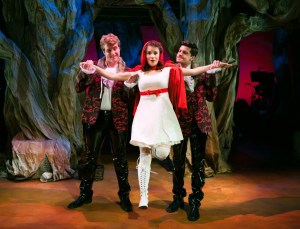
Corinne Proctor, as Little Red, definitely struggling with one too many moral quandaries (Jeffrey Brian Adams and Ryan McCraryin the SF Playhouse production of INTO THE WOODS. Photo by Jessica Palopoli.
Brian: I’ve noticed that I am apparently the only one on this panel drawn primarily to the father/son relationship, so bear that in mind with this answer, but in the end, this is a story about relationships, and the first thing we learn is that there is a childless baker, and we then soon learn his father is possibly dead from “a baking accident,” but then probably ran away from life. The baker is internally convinced he IS his father, and has trepidation about having/raising children, especially after his wife is gone. This is what takes Woods from being a fun mash-up of fairy tales to something deeper for me. It’s about not succumbing to our fears, and all characters have this, but what really hits me hard, so “works for me”, is the Baker’s story-line, and how in the end he learns there is true strength inside him – not just giant-battling (that’s kind of easy) but being able to take responsibility for raising another human being.

Brian Katz, deep in the Humboldt redwoods with a mysterious man of his own- CMTC’s first TD, Dave Ampola (left).
Marissa: Reading the first round of the panel discussion and seeing the huge outpouring of affection for the Baker and the Baker’s Wife made me fully comprehend just how well that element of the story works, and how it’s another thing that I should have credited James Lapine for when we were discussing what’s successful about the book of Into the Woods. It’s hard enough to make familiar fairy-tale characters like Cinderella or Little Red seem human and complex, but I’d wager that it’s even harder to create original characters who coexist in the same world as the familiar characters and have the most meaningful journeys of all. The Baker and Baker’s Wife may have originated as a gimmick to tie together the stories of Cinderella, Jack, Little Red and Rapunzel, but they became so much more than that — they offer a modern, adult audience a way into the story, through a fairy tale that was specifically designed to resonate with yuppie New York theatergoers. (Kids and teens are likelier to find their way into the story through identifying with Cinderella, Jack, Little Red or Rapunzel — because those stories are familiar and, as Brian pointed out, they’re about adolescents coming of age. Adult theatergoers required another way in.)
What have you learned from the show- both as a person and as a theater maker? How has it influenced you?
Oren: “Never wear mauve at a ball. Or pink.” No, but there are so many things! I’m going to reach into the hat of my brain and just say whichever things I pull out first, but trust me there’s a whole lot more where these came from. First, if you haven’t heard me harp on about transitions you’ve probably never spoken to me at all. People tend to forget transitions, but they can suck all the life out of a show if they don’t flow. Every transition in Woods is totally seamless, and it’s beautiful. I think it’s also encouraged me to tell complicated stories – I like it when there are lots of words and lots of characters, and everything is firing off in different directions, but it’s all making one connected, complete, unified picture –– and I think I only got there because I encountered Woods right when I first started writing. It was also the first musical I encountered with rhythmic speech and sung-through scenes (“Very Nice Prince” I’m lookin’ at you), but they sound totally organic (not quite natural, but like exactly how the character would talk). I think that gave me a lot more confidence to tackle things like, for example, writing an entire play in iambic pentameter. Or an essay on a college exam, but that’s another story.
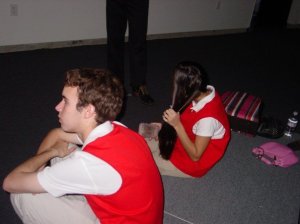
Oren Stevens, learning all the different things theater could be, as the Baker in INTO THE WOODS, set in a Walmart.
Marissa: I think Into the Woods made me see how I could engage with fairy tales on an adult level, how I could grow up and still remain attached to the stories of my youth. When I first saw the show age 12, I definitely enjoyed it, but my dad could not stop talking about how awesome it was, in particular the brilliance of how Act II shows you “what happens after Happily Ever After.” And I think it was really beneficial for me to see my dad react that way. When you’re 12 years old and in junior high school, there’s all this peer pressure to stop acting like a kid and start acting like a teenager. But there were so many things I loved about being a kid, especially the fact that it was socially acceptable to like fantasy and magic and fairy tales. I really didn’t want to give those things up! Later on, of course, I learned that there’s a whole 20th-century tradition of smart adult artists engaging with fairy tales in a serious way: Jean Cocteau’s La Belle et la Bete, Angela Carter’s The Bloody Chamber… But Into the Woods was my introduction to that kind of art, and I was glad to learn that fairy tales didn’t have to end when childhood did. I don’t know if Into the Woods has influenced me as a theater-maker — I don’t write musicals, and while I like shows with large casts and lots of moving parts, I’ve never sat down and looked at the book of Woods and said “let me see how James Lapine did that.” Perhaps, though, Into the Woods serves as Exhibit A for a theory I’ve been developing: if you want to write plays that deal with big philosophical issues, but you actually want people to come see them, you need to pair the big themes with a shiny/humorous/entertaining “hook” that gets people into the theater. I don’t know how successful I’ve been at this (either at engaging deep themes or at pairing them with cool hooks) but it’s something I’ve been thinking about, at any rate.
Nick: This is really gonna be the most cheese-ball thing I write, like, ever, but I guess this show always makes me think of my parents and the way they raised me. When I was younger I was a bit of a Rapunzel – no music aside from country and the occasional soft rock favorite. No R-rated movies until I was 16. Phone updates as to my whereabouts at regular intervals. My parents kept the leash pretty tight, and it was only after I escaped to college that I fully realized this. But I think about how people make mistakes – fathers, mothers. I think about how scared shitless I’d be if I was raising a child in this world full of wolves. I can’t say I’d raise my child under such heavy supervision, but I can’t say I wouldn’t be frightened all the time of making a mistake, of letting them get hurt. As an artist, this was the show that taught me how to direct, plain and simple. As an actor, it helped me to understand a show from a director’s perspective, and as a theater artist in general, it taught me that I was capable of so much more than just acting.
Stuart: Identifying as strongly as I did with one character at such a young age, I was able to pull from Into the Woods both comfort and a kind of vocabulary for beginning to talk about myself and others, and society and the world. It really introduced me to the concept and power of archetypes, both in narrative and life, and it was most definitely the beginning of my own personal cosmology, which has been developing ever since, and is a sort of hodgepodge of medieval legends and Greek mythology. As an artist in general, I think it’s safe to say that my whole life has been more or less dedicated to both preserving and reinventing our mythological roots, and Into the Woods certainly plays a role in that. As a director, Broadway in general has been hugely important (you’ll notice, I basically direct all plays as if they were musicals), at least as important as independent film has been (you’ll notice, I basically direct all plays as indie films). It’s as a writer, however, that I think Woods‘ influence is most evident in my work: even when I’m not writing new versions of old stories, I still tend to create larger stories about groups of people, ensemble plays with multiple lead roles and through lines, and I love breaking the fourth wall, direct address, post-modern structural twists, and surprising you with characters who don’t always act the way you expect them to. But perhaps most of all, I pride myself on writing plays where even the smaller roles are complex, nuanced, and everybody, good or bad, has a soul. I’m big into compassion, as an artist, and as a human being, and I definitely learned that value from Into The Woods, where compassion ultimately wins the day. Especially storytelling as an act of compassion.
Brian: The line that hits me hard at the end is “Children may not obey / But children will listen.” I think about that a lot when I teach, and sometimes when I direct; it is a reminder that even if someone is rebelling, pushing buttons, just being what one would consider “difficult,” they are still looking to you. Rejecting a parent/teacher/authority figure is often a necessary stage in someone finding their own path through the woods; the ones who come out of that darkness are the ones you truly reached. As for being an artist… two words: James Lapine. He is an early influence, although Sunday is the show that blew my mind, specifically at the moment George doesn’t like where a tree was onstage, and then it disappeared. The psychological reach of that was, of course, that nothing you see here is real. Or maybe it is, but it can all be altered at a moment’s notice by the creative forces telling us the story. Woods has moments like that too, when Milky White is simply picked up, when the Witch transforms, with the narrator’s warning of the story out of control. I love the deceptive simplicity of Lapine’s staging and writing, and try to remember is whenever I’m stuck: a tree can disappear, if we simply will it.
Corinne: Having the great good luck to work on the show at both 18 and 28 has reinforced for me how much you can find in a piece when you really dig into it. There’s a lot in this show that can pass you by the first few times, but there is SO much there once you begin to pay closer attention. On a more pragmatic level, it’s where I learned how to sing harmony – but only for 5 notes: “MAYBE WE FORGOT!”
And last but not least… what’s the moral of the story?
Corinne: Morality is self-determined; there is no “right” way to live.
Brian:I know this is the obvious choice, but it really is CHILDREN WILL LISTEN, with the added thought that we are all children in this way, we all need these stories to help us navigate life. That is the reason for all the humor, pathos, wrong turns, magic beans, and deaths. It is the reason we do theatre in the first place, or maybe it is how we justify spending a life in the theatre, we have to believe that someone is listening. That the tales we tell, even if misunderstood, mangled, applauded or scorned, have touched at least one person that night, and helped them work through something. Or maybe take something else less seriously, or maybe more seriously, or create empathy, sympathy or maybe just made them laugh when they really needed it. The point is, they are listening, watching, and learning. To me, to always know this is the responsibility of the artist, and our contract with the audience. Careful before you say, “listen to me.” Into The Woods says it better, in its finale, than any other show I can think of: “What do you leave to your child when you’re dead?/Only whatever you put in its head/Things that you’re mother and father had said/Which were left to them too…” This is how our stories continue, and within them are all the truths, lessons and myths we, in the theatre, try to pass along.
Oren: The first act is so full of morals. Every midnight we get another smorgasbord (opportunity is not a lengthy visitor, the slotted spoon won’t hold much soup, the prettier the flower the farther from the path) but in the end we get the truth: shit’s complicated. The point of “Children Will Listen” (which sits exactly where the moral should go) isn’t “be careful what you wish for” but “careful the things you say.” Ultimately what we’re warned about isn’t yearning –– we couldn’t stop that if we tried –– we’re warned against telling these stories thoughtlessly, teaching our children empty, hollow, meaningless lessons that simplify and diminish the world. I know, it’s not fun, but god damn if it isn’t the prettiest song you ever heard.
Marissa: What ISN’T the moral of the story? Trying to distill the musical’s many morals, both explicit and implied, into one overarching message, I’m tempted to say that all has to do with cycles of various kinds. Wisdom is passed from parents to children, who grow up and have their own children. Violence is a cycle and it takes extraordinary effort and courage to break the cycle. One wish begets another. You go into the woods, you come out of the woods, you go back to the woods. And you can’t run from your problems because you can’t run from yourself — no matter where you go, you’ll still be part of that great cycle of birth and maturity and decline and death.
Stuart: Life is complicated. Life is complicated and it’s never going to cease being complicated until you’re dead- and then, we’re actually only assuming that because we don’t know what happens after we die. I mean, in Into The Woods, if you’re the Baker’s Wife, or the Mysterious Man, or Cinderella’s Mother, or Jack’s Mother, or Little Red for that matter, death isn’t exactly the end, isn’t? Even beyond the grave, our stories continue, our influence continues to work itself on the people who shared the world with us and live in it after we’re gone. Life is complicated because everything is connected- there are paths between point A and point B, but also point X, and point Q, and point D, and point O. Far too many points than we can really see or even, maybe, begin to see, sometimes because the woods are dark and sometimes because we’re blind and sometimes because we’re just not meant to see all these paths because if we did, we’d almost certainly lose our way. Not that it’s the end of the world when we do lose our way- sometimes we have to do that, to find it again. Few paths are straight, and all paths lead into the woods… but all paths lead out of them too. And there’s always a light to guide you, you just have to find it, believe in it, wish for it. If there’s one moral in Into the Woods for me, it’s that: “Hold him to the light now/let him see the glow/things will turn out right now/tell him what you know.”
Nick: “No one is alone…” And no prosthetic wolf dongs.
We hope you have enjoyed our panel on INTO THE WOODS. We’ll do a follow up after the movie is out and we’ve all had a chance to see it. In the meantime, leave us questions and comments below!
